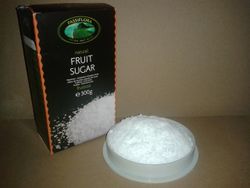Fructose
 Store-grade fructose
| |
| Names | |
|---|---|
| IUPAC name
1,3,4,5,6-Pentahydroxy-2-hexanone
| |
| Systematic IUPAC name
1,3,4,5,6-Pentahydroxy-2-hexanone | |
| Other names
Fruit sugar
levulose D-fructofuranose D-fructose D-arabino-hexulose | |
| Identifiers | |
| Jmol-3D images | Image |
| |
| Properties | |
| C6H12O6 | |
| Density | 1.694 g/cm3 |
| Melting point | 103 °C (217 °F; 376 K) |
| Boiling point | Decomposes |
| Hazards | |
| Safety data sheet | ScienceLab |
| Lethal dose or concentration (LD, LC): | |
| LD50 (Median dose)
|
15000 mg/kg (intravenous, rabbit) |
| Related compounds | |
| Related compounds
|
Glucose |
| Except where otherwise noted, data are given for materials in their standard state (at 25 °C [77 °F], 100 kPa). | |
| Infobox references | |
Fructose, also known as fruit sugar, is a simple ketonic monosaccharide found in many plants and fruits, where it is generally bonded to glucose to form the disaccharide sucrose.
Contents
Properties
Chemical
Fructose may be anaerobically fermented by yeast or bacteria to ethanol, releasing carbon dioxide.
When mixed with an oxidizer, such as potassium nitrate, it will burn vigorously.
Physical
Fructose is a white or transparent crystalline solid, soluble in water.
Availability
Fructose is sold in most food stores, supermarkets or hypermarkets. Prices depend on the brand.
Preparation
Fructose can be prepared through the hydrolysis of table sugar (sucrose) in warm water, in the presence of potassium bitartrate or citric acid. The resulting fructose is recrystallized from the mixture.
Projects
- Smoke bombs
- Make amorphous carbon
- Hydroxymethylfurfural (HMF) synthesis
Handling
Safety
Fructose has extremely low toxicity, but it's best to avoid consuming lab-grade reagent.
Storage
In any containers and kept in dry places, away from mold.
Disposal
Fructose can be safely burned, dumped in ground or poured down the drain.
References
Relevant Sciencemadness threads
- Chemical pages without CAS Registry Number
- Articles without EBI source
- Chemical pages without ChemSpiderID
- Chemical pages without DrugBank identifier
- Articles without KEGG source
- Articles without InChI source
- Articles without UNII source
- Articles containing unverified chemical infoboxes
- Chemical compounds
- Organic compounds
- Biologically-derived compounds
- Sugars
- Monosaccharides
- Readily available chemicals
- Materials available as food grade
- Edible chemicals